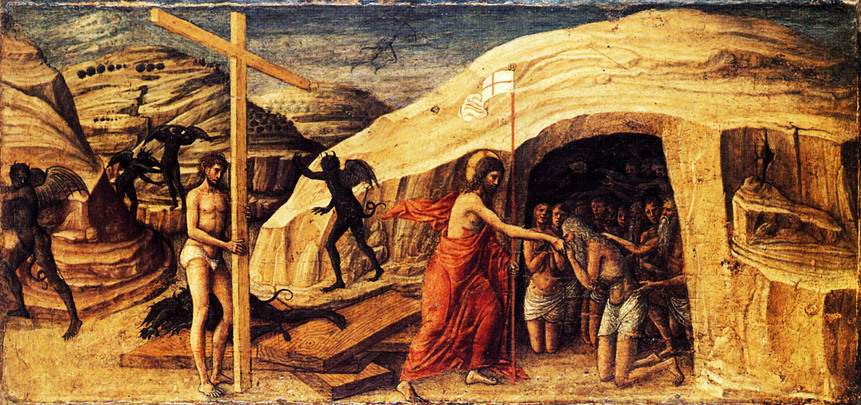

About fifty years ago, when I was in third or fourth grade, the Art Teacher asked us: If you were a tree, what kind of tree would you like to be? Draw a picture, and label it. This rather stumped me.
What would it be like to be a tree? I had never thought of this before. What kind of a tree would I like to be? I did not see how this question could be answered. Anyway, I sat there thinking, and the teacher came by and asked why I hadn't drawn anything yet. This got me going, and I came to a decision.
I decided that I would like to be the kind of tree that children liked to play under. Miss Art explained that that was not what she meant: Would I like to be an Elm, or a Maple tree?
I drew a Weeping Willow because the incomprehensibility (and incomprehension) of adults saddened me. Also they were easy to draw.
So, on to the point of all this. Why Saint Dismas?
Around the same time, I encountered the question: If you could be anybody, who would you want to be? This one, at the time, seemed easier to answer. I don't remember who my hero of the month was at that time --- probably some ball player, or an astronaut --- but I chose him. Or perhaps Scrooge McDuck, who seemed pretty cool to me at the time.
As the years went on, this question continued to bother me. Who would I like to be? On the general `better the devil you know' principal, choosing myself seems safest; but this, like any other answer just doesn't satisfy.
And then I discovered Saint Dismas --- the only person declared a saint by God himself! This seemed like a pretty good deal to me.
Saint Dismas is also known as the Penitent Thief, the Good Thief, or the Thief on the Cross. All we know for certain is:
32 And there were led also other two malefactours with him, to be executed. 33 And after they came to the place which is called Calvarie, there they crucified him: and the theeves, one on the right hand and the other on the left.
39 And one of those theeves that were hanged, blasphemed him, saying: If thou be Christ, save thy self, and us. 40 But the other answering, rebuked him, saying: Neither doest thou feare God, where as thou art in the same damnation? 41 And we indeed justly, for we receive worthie of our doings: but this man hath done no evil. 42 And he said to Jesus: Lord, remember me when thou shalt come into thy Kingdom. 43 And Jesus said to him: Amen I say to thee; this day thou shalt be with me in Paradise.
[Dismas] belonged to a band of robbers who infested the frontiers of Egypt; and it was in a cave inhabited by these robbers that the Holy Family took refuge when flying into Egypt, at the time of the massacre of the Innocents. The poor leprous child, who was instantly cleansed by being dipped in the water which had been used for washing the infant Jesus, was no other than this Dismas, and the charity of his mother, in receiving and granting hospitality to the Holy Family, had been rewarded by the cure of her child; while this outward purification was an emblem of the inward purification which was afterwards accomplished in the soul of Dismas on Mount Calvary, through that Sacred Blood which was then shed on the cross for our redemption.
He was an Egyptian pagan, the son of a career criminal, who followed in and exceeded his father’s wickedness. Dismas spent his entire life robbing people, and was also a murderer. He attempted to rob the Holy Family as they made their flight into Egypt. They had nothing to steal, but beyond that, Dismas was affected by the Infant Christ. Dismas continued his life of crime, and was caught and due to his litany of crimes and infamy, was put to the most horrific death possible: crucifixion. By grace, he repented, confessed Christ, died, and was one of the very first, if not the first person to enter Heaven.
Perhaps you have noticed that on a Crucifix, Christ's head is usually tilted to the right. This is because Saint Dismas was crucified to his right. Additionally, many images of the Harrowing of Hell show St. Dismas, carrying his cross, directly behind and with Christ.

Saint Dismas is a great symbol of our hope. If he could be saved, perhaps I can be too!